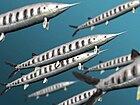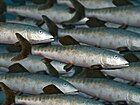
Lungfish are freshwater rhipidistian vertebrates belonging to the order Dipnoi. Lungfish are best known for retaining ancestral characteristics within the Osteichthyes, including the ability to breathe air, and ancestral structures within Sarcopterygii, including the presence of lobed fins with a well-developed internal skeleton. Lungfish represent the closest living relatives of the tetrapods.

A dorsal fin is a fin located on the back of most marine and freshwater vertebrates within various taxa of the animal kingdom. Many species of animals possessing dorsal fins are not particularly closely related to each other, though through convergent evolution they have independently evolved external superficial fish-like body plans ideal for their marine environments, including most numerously fish, but also mammals such as cetaceans, and even extinct ancient marine reptiles such as various known species of ichthyosaurs. Most species have only one dorsal fin, but some have two or three.
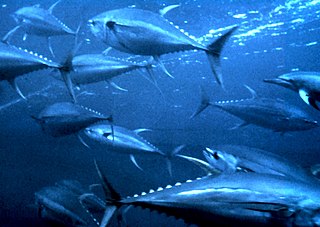
Fish locomotion is the various types of animal locomotion used by fish, principally by swimming. This is achieved in different groups of fish by a variety of mechanisms of propulsion, most often by wave-like lateral flexions of the fish's body and tail in water, and in various specialised fish by motions of the fins. The major forms of locomotion in fish are:
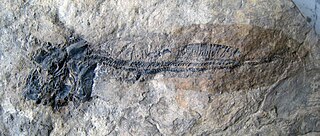
Ctenurella is an extinct genus of ptyctodont placoderm from the Late Devonian of Germany. The first fossils were found in the Strunde valley in the Paffrather Kalkmulde.

Dapedium is an extinct genus of primitive neopterygian ray-finned fish. The first-described finding was an example of D. politum, found in the Lower Lias of Lyme Regis, on the Jurassic Coast of England. Dapedium lived in the late Triassic and Jurassic periods.

Arandaspis prionotolepis is an extinct species of jawless fish that lived in the Ordovician period, about 480 to 470 million years ago. Its remains were found in the Stairway Sandstone near Alice Springs, Australia in 1959, but it was not determined that they were the oldest known vertebrates until the late 1960s. Arandaspis is named after a local Aboriginal tribe, the Aranda.

Cheirolepis is an extinct genus of ray-finned fish that lived in the Devonian period of Europe and North America. It is the only genus yet known within the family Cheirolepidae and the order Cheirolepiformes. It was among the most basal of the Devonian actinopterygians and is considered the first to possess the "standard" dermal cranial bones seen in later actinopterygians.
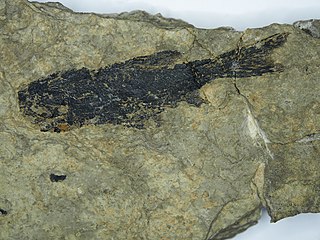
Moythomasia is an extinct genus of early ray-finned fish from the Devonian period of Europe and Australia.

Platysomus is an extinct genus of ray-finned fish that lived in the Carboniferous and Permian periods. Fossils have been found worldwide.

Hypsocormus is an extinct genus of pachycormid fish from the Middle to Late Jurassic of Europe. Fossils have been found in Germany, France and the UK.

Pholidophorus is an extinct genus of stem-teleost fish from the Triassic period of Africa, Europe, and South America.

Thrissops is an extinct genus of stem-teleost fish from the Jurassic and Cretaceous periods. Its fossils are known from the Solnhofen Limestone, as well as the Kimmeridge Clay.

Strunius is an extinct genus of lobe-finned fish from the Late Devonian period of Germany.
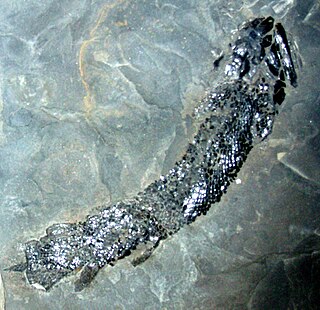
Gyroptychius is an extinct genus of osteolepiform lobe-finned fish from the Devonian period.

Holoptychius is an extinct genus of porolepiform lobe-finned fish from the Middle Devonian to Carboniferous (Mississippian) periods. It is known from fossils worldwide. The genus was first described by Louis Agassiz in 1839.

The barred conger is a species of conger eel that lives in the tropical western and central Indo-Pacific region. It is also known as the barred sand conger. It is a bottom-dwelling fish and is found in the waters around Madagascar, Indonesia, the Marshall Islands, Hawaii and Tahiti and some other island groups.

The snake mackerel is a species of fish in the monotypic genus Gempylus, belonging to the family Gempylidae. It is found worldwide in tropical and subtropical oceans between the latitudes of 42°N and 40°S; adults are known to stray into temperate waters. It is found to a depth of 600 meters. Populations of the snake mackerel from the Atlantic and the Indo-Pacific differ in vertebral count and number of first dorsal fin spines, and so may represent separate species.

Fins are distinctive anatomical features composed of bony spines or rays protruding from the body of a fish. They are covered with skin and joined together either in a webbed fashion, as seen in most bony fish, or similar to a flipper, as seen in sharks. Apart from the tail or caudal fin, fish fins have no direct connection with the spine and are supported only by muscles. Their principal function is to help the fish swim.

The evolution of fish began about 530 million years ago during the Cambrian explosion. It was during this time that the early chordates developed the skull and the vertebral column, leading to the first craniates and vertebrates. The first fish lineages belong to the Agnatha, or jawless fish. Early examples include Haikouichthys. During the late Cambrian, eel-like jawless fish called the conodonts, and small mostly armoured fish known as ostracoderms, first appeared. Most jawless fish are now extinct; but the extant lampreys may approximate ancient pre-jawed fish. Lampreys belong to the Cyclostomata, which includes the extant hagfish, and this group may have split early on from other agnathans.

Dorsetichthys is an extinct genus of stem-teleost ray-finned fish from the Early Jurassic period of Europe.






















